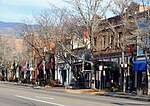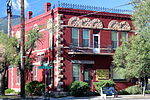Second Midland School
Buildings and structures in Colorado Springs, ColoradoColorado Registered Historic Place stubsColorado State Register of Historic PropertiesNational Register of Historic Places in Colorado Springs, ColoradoSchool buildings on the National Register of Historic Places in Colorado ... and 1 more
Use mdy dates from August 2023

The Second Midland School is a former school in Colorado Springs. Built in 1902, it was added to the National Register of Historic Places (NRHP) on September 12, 1980. The building is three stories tall and is made of red sandstone and brick.The school property was purchased by L Ducett to be used as an office building. The building was fully renovated with assistance of 25 High School students and localcraftsmen. The existing school rooms (including restrooms and the stage and library) blackboards and flagpole were all retained and used. The Eskanos later sold the property to a group that planned to convert it into a Catholic grade school .
Excerpt from the Wikipedia article Second Midland School (License: CC BY-SA 3.0, Authors, Images).Second Midland School
Howbert Street, Colorado Springs
Geographical coordinates (GPS) Address Nearby Places Show on map
Geographical coordinates (GPS)
| Latitude | Longitude |
|---|---|
| N 38.84091 ° | E -104.86734 ° |
Address
Howbert Street 2466
80904 Colorado Springs
Colorado, United States
Open on Google Maps










